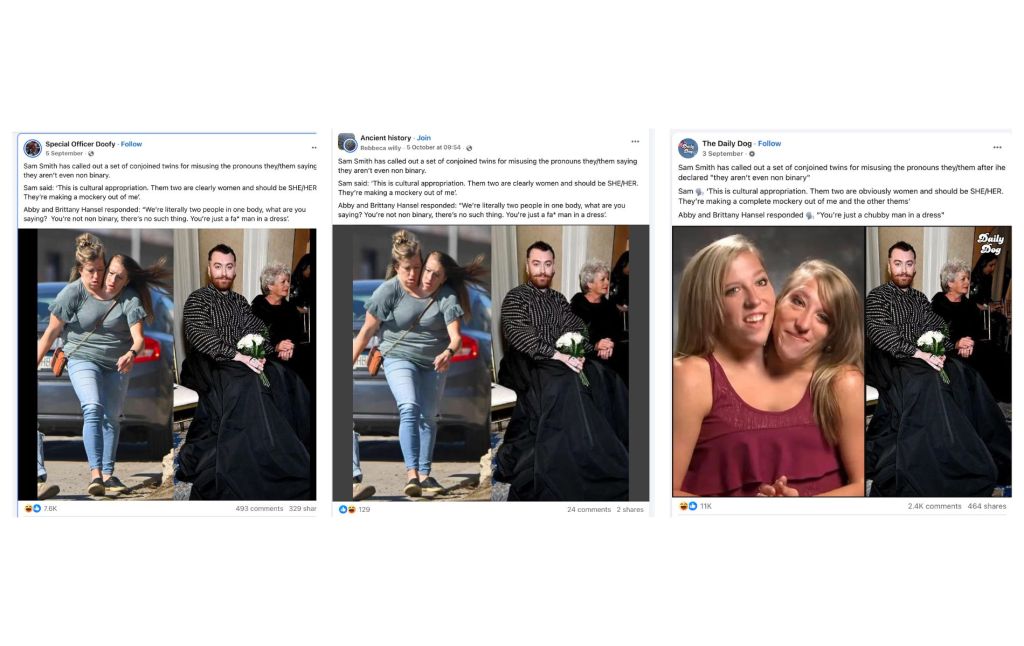Dallas Cowboys wide receiver CeeDee Lamb refused to wear a rainbow armband during a game, Olympian Mollie O’Callaghan pledged to no longer compete if trans swimmer Lia Thomas is allowed to, and singer Sam Smith took issue with conjoined twins Abby and Brittany Hensel, as two individuals, using they/them pronouns.
You might have seen these divisive posts on Facebook, you might even have been outraged by them or shared them, but they’re not real – they are anti-LGBTQ+ disinformation falsely framed as legitimate news content.
You only need to make a cursory Google search to see the claims can be easily disproven.
Sports editor David Evans, writing for Sportscasting, concluded the story about Lamb was fabricated because there is absolutely no source for his alleged quote nor did any reputable sports outlet run coverage on it.
Swimming Australia swiftly issued a public statement declaring the comments attributed to O’Callaghan, and subsequently fellow swimmer Kyle Chalmers, were fake.
Sam Smith has already been subject to countless – often contradictory – hoax stories about their gender, pronouns and relationship status, many of which have been debunked by various publications over the years.

As important as it is for those impacted by fabricated content to clarify when a piece of information is absolutely not real, the simple fact is that the truth alone is not enough to rectify the power of fake news in this predominantly digital-first era we live in.
At a time when social media fact-checking and moderation is in decline, algorithmic rules govern our social media feeds – often reinforcing our own unconscious biases and echo chambers – and the lines between reality and fantasy are increasingly being blurred by AI, it is more and more difficult for many people to consistently tell fact from fiction.
Fake news, a worrying MIT report found in 2018, travels faster and more widely than the truth.
A user who viewed such fake anti-LGBTQ+ posts as referenced earlier and instantly believes it to be true, perhaps because of their own prejudices and/or lack of skills at verifying the validity of media, would be unlikely to purposefully seek out any fact-checking. They would not think they need to – they saw it on Facebook, you see, so it must be true.
A more discerning user, however, might instantly be able to tell the post is nothing more than clickbait and/or engagement farming, or at the very least it is misleading and perhaps twisting someone’s original words.
Indeed, there are large swathes of the population who believe they are good at spotting fake news but studies frequently find they are often overconfident and still extremely susceptible to it.
They, as much as those who come to their social media feeds with already prejudiced opinions towards LGBTQ+ folks, are being targeted by bad actors seeking to weaponise anti-LGBTQ+ content to sow division in society.
These bad actors create content with the purpose of reaching average people in a society, honing in on their fears and anxieties about the state and future of their community, outraging them and, ultimately, shifting their opinions on queer rights, legislation enacted by their government, the trustworthiness of their elected leaders and undercutting democracy as a whole.

Misinformation and disinformation – two distinctly different but intertwined concepts – are certainly nothing new and have been a part of the media ecosystem as long as verifiable news has been.
While misinformation refers to the spread of falsehoods via genuine misunderstanding or mistake, disinformation is far more sinister and instead refers to the process by which entirely false information is created, propagated and disseminated on purpose, with the aim of pushing a particular narrative or agenda to achieve a set of political goals.
Misinformation about the LGBTQ+ community could include someone misinterpreting the data in a report on gender-affirming care or thinking someone has come out when they actually haven’t, for example.
Anti-LGBTQ+ disinformation, on the other hand, includes the far-right “groomer” conspiracy theory which inherently links LGBTQ+ people to vile child abuse, claims pushed by Donald Trump that school teachers are performing gender-affirming surgeries on pupils in classrooms, and the recent posts above falsely attributed to notable athletes and other famous names.
In recent months, there has been an increasing number of posts appearing on social media – namely Meta platforms Facebook and Instagram – which are stylised to look like the image-based breaking news posts often used by media organisations, despite the fact they are being posted by the furthest thing from a news source.
The posts are usually overlaid with a quote or headline and captioned with some sort of breaking news kicker and the start of what looks like copy for a published news story.
In many cases, the same post – using the same image and caption – is shared across various different pages for maximum reach.
Many of the posts consistently appear to be about trans rights, namely the hot button issue of trans inclusion in sports or specific gender identities, with many referencing trans American swimmer Lia Thomas.
In 2022, Thomas made history as the first trans woman to win a National Collegiate Athletic Association swimming championship. She has since become a key figure in the right’s war against trans athletes.

PinkNews was unable to verify who was behind the Facebook pages which are sharing the current wave of anti-LGBTQ+ disinformation.
Foreign Information Manipulation and Interference
However, similar tactics have been used by bad actors in the past and in national security circles as Foreign Information Manipulation and Interference (FIMI), which the EU defines as a “pattern of behaviour that threatens or has the potential to negatively impact values, procedures and political processes” wherein such activity “often seeks to stoke polarisation and divisions inside and outside the EU while also aiming to undermine the EU’s global standing and ability to pursue its policy objectives and interests”.
A 2023 EU report entitled ‘FIMI targeting LGBTIQ+ people: Well-informed analysis to protect human rights and diversity’ – the first of which to specifically focus on anti-LGBTQ+ FIMI – found 31 cases related to FIMI and the queer community between June 2022 and July 2023, with half of the cases attributed to Russia.
The report found that anti-LGBTQ+ FIMI is politically motivated and seeks to harden public opinion in opposition to LGBTQ+ rights, along with sowing divisions in communities and undermining democracy.
“The reach of FIMI cases targeting LGBTIQ+ goes beyond this community,” the report reads. “According to the evidence collected during the investigation, FIMI actors aimed to provoke public outrage not only against named LGBTIQ+ individuals, communities, or organisations – but also against government policies, the concept of democracy as such, and local or geopolitical events.
“While undermining LGBTIQ+ people was a common theme in many of the FIMI cases identified, the overarching narrative in many of them was that the West is in decline.
“By leveraging the narrative of decline, FIMI threat actors attempt to drive a wedge between traditional values and democracies.
“They claim that children need to be protected from LGBTIQ+ people, that LGBTIQ+ people get preferential treatment in sports and other fields – to the detriment of others – and that Western liberal organisations or political groups are demonstrably weak because they surrender to “LGBTIQ+ propaganda”.”
Fake content “keeps debates falsely alive”
Speaking to PinkNews, Dr Dani Madrid-Morales – lecturer in journalism and global communication at the University of Sheffield and co-Lead of the university’s Disinformation Research Cluster, said the style of anti-LGBTQ+ posts currently being shared on Facebook are “a very common approach that different actors use”.
Madrid-Morales noted that whilst political actors certainly use these coordinated strategies for a particular end goal, they are also used by isolated individuals who “benefit economically from creating this content that is highly polarizing [and] that’s likely to get a lot of engagement”.
He went on to explain that the content, of course, has a negative impact on the community it is focused on directly but “more broadly, it sort of keeps these debates sometimes falsely alive in the sense that in the political arena”.
“By keeping these debates really highly active on social media, certain groups benefit from being able to say, ‘oh, look, people are really interested in us talking about this’, because a lot of people on social media are discussing these topics and sometimes it’s very artificially inflated.
“We’ve seen that before with other topics, for example health disinformation and anti-vax campaigners, where they create false information.
“They use amplification techniques on social media to get that widely spread, and then they create the false illusion that’s a topic that people are really concerned about when in reality it’s not.”
PinkNews has approached Meta for comment.
The post What – or who – is behind the troubling and sinister rise in fake LGBTQ+ news on Facebook? appeared first on PinkNews | Latest lesbian, gay, bi and trans news | LGBTQ+ news.






